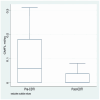Effects of Five Years of Treatment of Onchocerciasis with Ivermectin under Community Guidelines in Resurgent Areas of Burkina Faso: A before-and-after Analysis
- PMID: 39330896
- PMCID: PMC11435634
- DOI: 10.3390/tropicalmed9090207
Effects of Five Years of Treatment of Onchocerciasis with Ivermectin under Community Guidelines in Resurgent Areas of Burkina Faso: A before-and-after Analysis
Abstract
Background: Almost the entire country of Burkina Faso was endemic to onchocerciasis. Onchocerciasis control efforts thus brought the prevalence of O. volvulus to a level where the disease was no longer a public health problem in 2002. A resurgence of onchocerciasis cases has been observed in two regions (Cascades and the Southwest) located around several river basins in 2010-2011. In accordance with WHO guidelines for the management of resurgent cases, community-directed treatment with ivermectin (CDTI) was implemented in the affected areas. The aim of this study was to determine the effects of this intervention on parasitological indices of onchocerciasis, depending on the distance between villages and rivers.
Methodology: We conducted a paired pre-post study using aggregated village-level data from two cross-sectional surveys conducted in each region. A Wilcoxon signed-rank test was used to compare the standardized microfilarodermia prevalence and community microfilarial load (CMFL).
Results: A total of 43 villages in 6 health districts, in the Southwest (18) and Cascades (25) regions were included in the study. The key findings were that standardized microfilaria prevalence and CMFL decreased significantly after the implementation of CDTI in both regions (p < 0.0001). The median standardized microfilaria prevalence was 2.8 [interquartile range (IQR): 0.2-6.6] before CDTI and 0.72 [IQR: 0.0-2.17] after CDTI. The results showed also a decline in standardized microfilaria prevalence and CMFL in all villages, regardless of the distance separating the village from the streams. However, the results were not statistically significant for the villages located 5 km or more from streams (p = 0.0816 and 0.0542 for standardized microfilaria prevalence and CMFL, respectively).
Conclusion: Our results thus show that the implementation of effective CDTI could stop the transmission of O. volvulus in these two regions. The main challenge for stopping transmission could be the migration of populations to neighboring countries and migration of the vector from one country to another, as Burkina Faso shares some river basins with neighboring countries.
Keywords: Burkina Faso; community guidelines; community microfilarial load; ivermectin; microfilarodermia; onchocerciasis; resurgent areas; standardized prevalence.
Conflict of interest statement
The authors declare that they have no conflicts of interest.
Figures




References
-
- Elimination of Human Onchocerciasis: Progress Report. 2021. [(accessed on 19 December 2022)]. Available online: https://www.who.int/publications/i/item/who-wer9746-591-598.
-
- Controlling Neglected Tropical Diseases to Achieve the Sustainable Development Goals: A Sustainability Framework for Action on Neglected Tropical Diseases 2021–2030. [(accessed on 20 December 2022)]. Available online: https://www.who.int/fr/publications-detail/9789240019027.
-
- World Health Organization . Integrating Neglected Tropical Diseases into the Global Health and Development Agenda: The Fourth WHO Report on Neglected Tropical Diseases. World Health Organization; Geneva, Switzerland: 2017. Policy Brief. Retrieved from Geneve.
LinkOut - more resources
Full Text Sources

